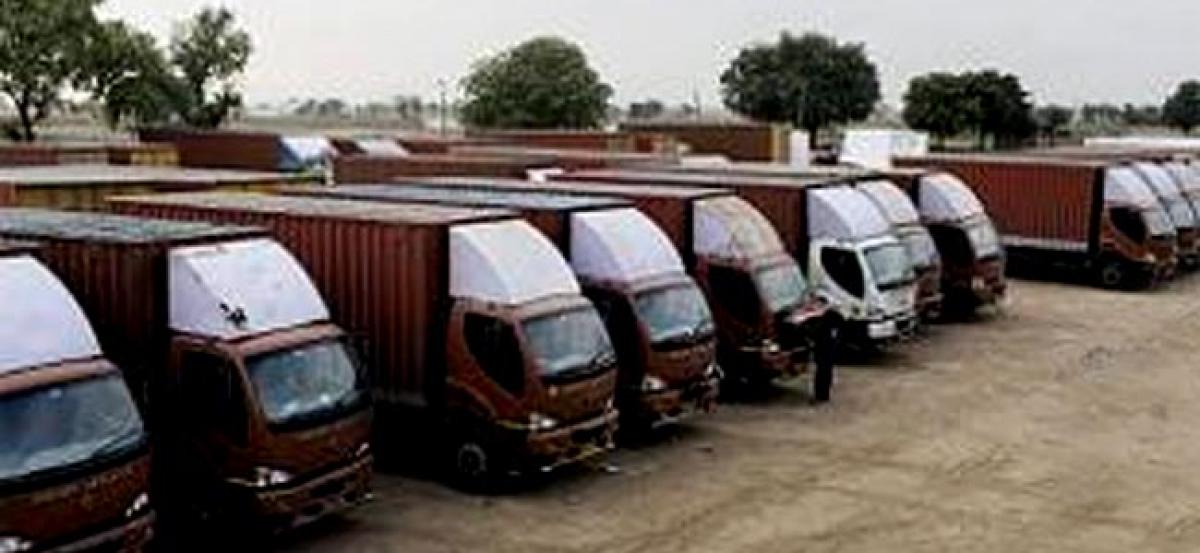Live
- AI Model Detects Residual Brain Tumors in 10 Seconds, Offers Real-Time Surgical Guidance
- Reliance and Disney Complete JV Deal to Strengthen Entertainment Presence in India
- UP Govt Agrees to Protesters’ Demand, PCS Exam to Be Held in One Day
- Trump’s Social Security Tax Promise Faces Hurdles: What Retirees Need to Know
- Strict Action Needed Against Attacks on Government Employees - Retired Employees
- Hyundai Motor India Limited Announces 2024 Edition of ‘Hyundai Always Around’ Campaign
- Minister for Environment, Forests, and Endowments Celebrates Karthika Pournami and Guru Nanak Jayanti
- World Quality Day: Hindustan Zinc Reaffirms Commitment to Superior Product Quality & Innovation
- Grand Kartika Purnima Celebrations at Nagar Kurnool’s Saraswati Shishu Mandir
- Children’s day celebrations, Karnataka remnisences on Nehru’s contributions
Just In

The brisk discount sales and incentives that commercial vehicle makers offered on BS-III units to meet the Supreme Court-set April 1 deadline would cost them Rs 2,500 crore, says a report. Giving a break-up of the impact on CV makers,
Mumbai: The brisk discount sales and incentives that commercial vehicle makers offered on BS-III units to meet the Supreme Court-set April 1 deadline would cost them Rs 2,500 crore, says a report. Giving a break-up of the impact on CV makers, research firm Crisil said the companies which have sold a little over half of their BS-III inventory by March 31, have lost Rs 1,200 crore on discounts and incentives and Rs 1,300 crore more to dispose of the unsold inventory. On the impact of this on the Ebidta margins of listed truck makers (Ashok Leyland and Tata Motors' standalone), the report says this is equal to 2.5 per cent of their revenue. However, the report says this will be staggered across fiscal 2017 and 2018, because the unsold inventory will have to be brought back from dealerships and then dealt with, which will happen only in the new financial year.
For the just concluded fiscal 2017, the BS-III discounts to crimp Ebitda margins by 100 bps. On the day of the final ruling the CV industry was left with inventories of around 97,000 units (equivalent to 1.7 months of sales) valued at Rs 11,600 crore. "The industry is expected to have sold around 55 per cent of this in the last three days of March by offering discounts of 20-40 per cent on the sticker price compared with 10 per cent before the ruling. These discounts and incentives are expected to have cost about Rs 1,200 crore of which the truck makers are likely to bear about 80 per cent and their dealers the rest. "That works out to a 300-350 basis points erosion in the aggregate fourth quarter Ebitda margins of Tata Motors and Ashok Leyland to near break-even--a level last seen in Q3 of fiscal 2015, when it was recovering from a sharp slowdown.
The impact for the full year works out to be 100 bps, which is significant considering Ebitda margins have not reached the pre-slowdown levels of 8-10 per cent," says the report. In fiscal 2016, margins peaked at 7.3 per cent and were trending 200 bps below in fiscal 2017 owing to subdued sales and rising raw material prices. "We estimate that the remaining 40,000-45,000 units of unsold inventory to be returned in the upcoming months, mainly comprising less-popular models. This will entail an additional Rs 1,300 crore loss on them," says the report. Crisil expects the truck makers to either upgrade the unsold BS-II models for resale, or dismantle them for spares or incur higher working capital for holding the inventory until it is exported, to manage the unsold BS-III inventory. But the report warns that recalling the stock from dealers and exporting them is time-consuming. Exports account for around 13 per cent of total annual CV sales.
It could take around five to six months to dispose of the remaining inventory in export markets with less stringent emission norms. But recalling the unsold inventory from dealers and upgrading to BS-IV is expected to cost north of 12-15 per cent of the vehicle price, excluding the cost and hassle of reverse logistics and additional labour costs. "Moving from BS-III to BS-IV also entails significant changes in the engine architecture, including engine fuel system, after-treatment system and more electronics, conversion of these vehicles into BS-IV could take several months," warns the report.
Assuming truck makers would incur an additional Rs 3-4 lakh per vehicle on reverse logistics and remodelling to BS-IV, it would mean an additional expense of Rs 1,300 crore, it says. April sales will be hit as dealers return their BS-III inventory and exchange them for BS-IV vehicles. With the pre- buying momentum gone and BS-IV vehicles priced higher, sales will be subdued in April despite dealers looking to stock up to normal levels.

© 2024 Hyderabad Media House Limited/The Hans India. All rights reserved. Powered by hocalwire.com







